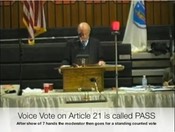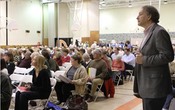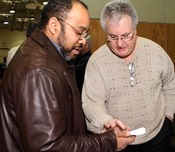It has been remarked: "If voting is not accurate then why even go to town meeting?"
Accurate voting means that every person who votes has their vote counted and counted correctly. The very early days of New England Town Meeting were attended by the land owners - those in control and in power in the village or small town. The meeting was usually held in a small place, a tavern or a church room or even the living quarters of a town resident. From an accuracy point of view, small audiences in small rooms pose little problem. Over time, town meeting audience sizes grew and so did the rooms that contained them.
The problem of town meeting voting accuracy has been a long standing problem. The previous methods to accomplish this do vary but they all have two things in common - they depend on the human senses and they fall victim to human error.
Voice voting also known as the 'shout vote' is the most common form of meeting vote tally and its also the most prone to error. Sound decreases in volume linearly. A person 10 feet from a listener has twice the impact that a person 20 feet from the listener does. At 40 feet the shouter only has 1/4th the sound impact on the listener. Then there are bad acoustics and of course, faulty human hearing. In the shout out its strictly Darwinian. To have maximum voting power you get close and you yell hard. This puts much of the audience at a disadvantage and its not possible to get any quantitative measure of 2/3rd's. When the shout vote is apparently within 20% or less, then the moderator has to resort to other, more time consuming means to get an accurate vote count. The shout vote is notoriously disenfranchising to people who attend town meeting.
Suppose you were not sure of the motion on the floor or was confused at the order of the vote? In shouting you get one giant impulse to shout vote and then its over. The sound is gone. If you voted the wrong way - there is no way to take it back.
In electronic voting a voting window is opened (light bulb on) and then 30 seconds later the voting window is closed (light bulb off). During that 30 second period of time you can privately vote Yea or Nay. If you change your mind and/or become *unconfused* as to what you were voting on, you just press your vote again. The last Yea or Nay that you press is the one that sticks. You get one vote and its the fully considered and corrected personal vote you wanted. Your private vote is transmitted by radio waves and is not subject to hall acoustics, distance from listener or subject to human error. Your vote is counted by a computer and all votes are tallied by that computer and presented to the moderator and town clerk for their announcement. In this, electronic voting adds yet more dimensions of voting accuracy.
Not only does electronic voting get rid of the time consuming and energy draining standing counted vote but it also does away with the shouted vote.
Other forms of human voting involve holding up colored cards, or a 'show of hands' or a non-counted stand-up. These are also all prone to the frailties of sight over distance and all have the inherent error sources of human estimation.
Town meeting is where the money is spent or NOT spent. Its where the zoning is created or is denied. Its where the town code is born.
Every decision made by town meeting affects every resident, every voter, every taxpayer of the town now and into the future. It affects all of these people whether can attend the town meeting or not. Getting the vote count right is imperitive and accuracy is the key.
If you want to accurately count something - use a computer - thats what electronic voting does.


